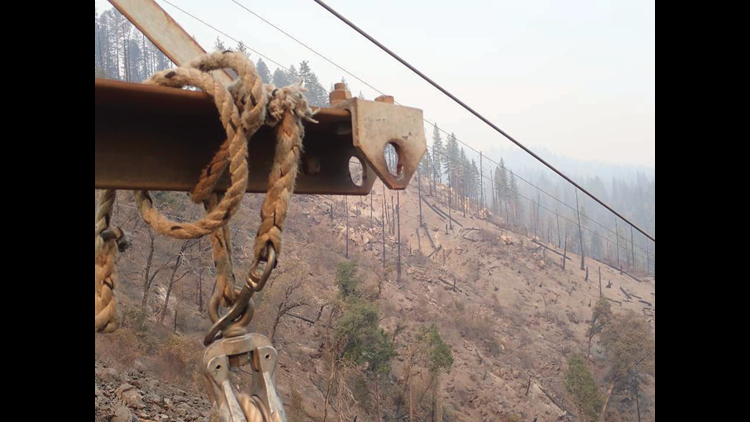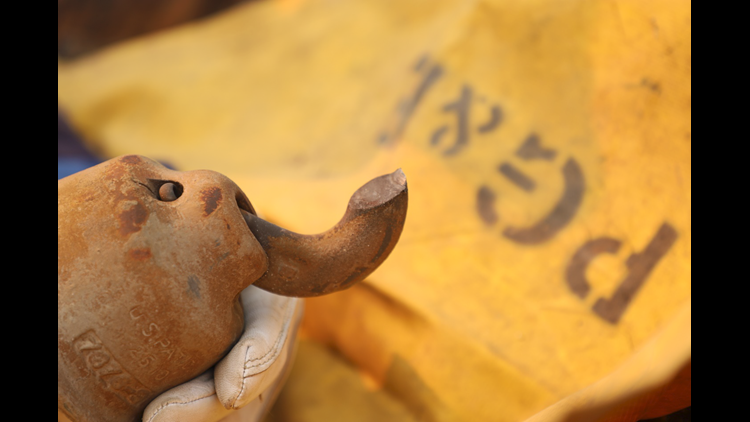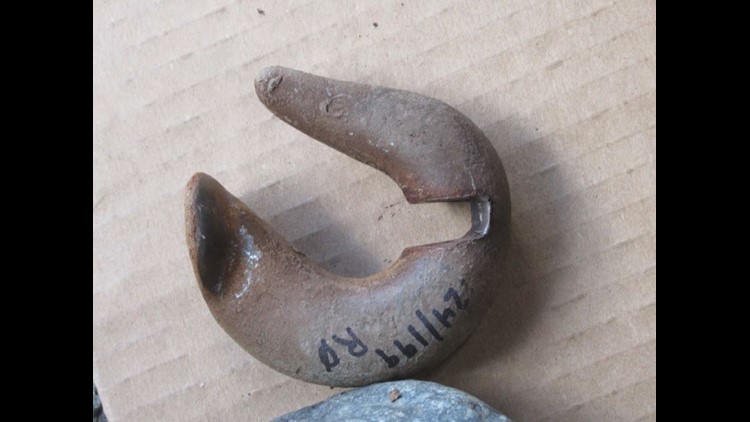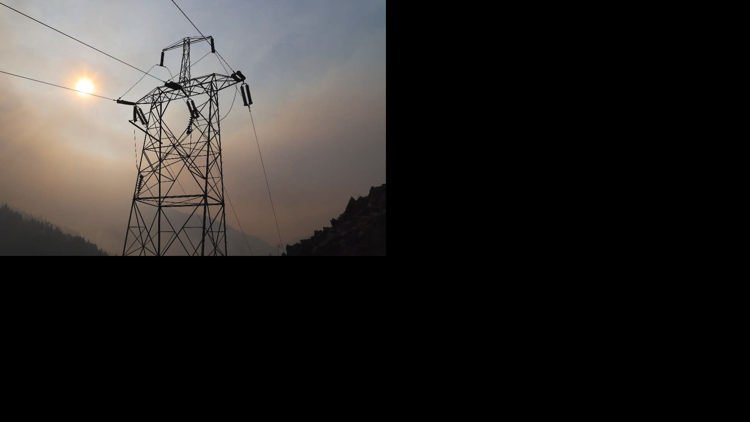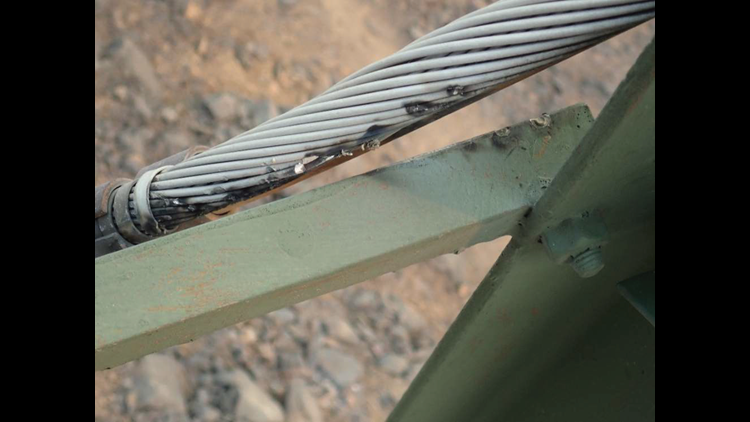SAN FRANCISCO —
Lending support to an accusation that PG&E should have known about the problem that sparked the 2018 Camp Fire, the company told a federal judge it "believes" it "may have" previously repaired the same problem in the same place once before.
The Camp Fire killed 85 people and destroyed the community of Paradise in November 2018. PG&E agrees that the fire sparked because a metal hook on its high-voltage Caribou power line snapped in the wind.
PG&E "could have identified the worn C-hook before it failed" and "could have prevented ignition of the Camp Fire," according to the results of an investigation released this month by the California Public Utilities Commission.
The CPUC report, nearly 700 pages long, says the hook broke because of years of wear from grinding against the hole in the metal plate where it hung,
The power line carries power from the 1920's-era Caribou hydroelectric plant down to the Central Valley through the Feather River Canyon, where the Camp Fire originated.
The same CPUC investigation also found that PG&E failed to climb up the tower for a detailed inspection, which was "a violation of PG&E's own policy requiring climbing inspection on towers where recurring problems exist."
In response, a federal judge is reviewing whether PG&E may have violated the terms of its criminal probation for a second time.
“We remain deeply sorry about the role our equipment had in tragic wildfires in recent years,” PG&E’s CEO Bill Johnson said in a written statement after the investigation was published. “We apologize to all those affected.”
THE EVIDENCE: WHY THE STATE SAYS PG&E SHOULD HAVE KNOWN
The proverbial smoking gun in the CPUC report is a photo of the part of the steel tower that held up the hook, showing two different holes where a hook can hang.
Both holes appear worn-down from their original circular shape:
Photo evidence from investigation of PG&E power line that caused the Camp Fire
The hole in the background is the original, according to the investigation. The hole in the foreground is part of a metal "hanger plate" that was bolted on later.
The wear on the original hole "should have been an indication of the potential for similar problems with wear on the added hanger plates," according to the CPUC report.
PG&E confirmed to a federal judge this week that the hook was hanging from the added hanger plate when it broke last year and that the company "believes" this part of the power line used to be held up by a hook attached to the original worn hole.
The bolted-on hanger plate "may have been installed to address wear on the original," PG&E said in a series of written answers to questions from the judge supervising the company's probation for federal crimes.
NO CLIMBING INSPECTION FOR "AT LEAST" 17 YEARS
"Known, recurring conditions" that threaten high-voltage lines are listed as a trigger for climbing inspections in PG&E's own policy manual, yet the CPUC report found that nothing triggered a climbing inspection of the tower in question since "at least 2001"-- 17 years before the fire.
However, PG&E did take photos of the tower on a helicopter patrol the year before the fire.
The company shared photos from this patrol with the judge, saying that they are the most recent known photographs of it from before the fire. All of these photos show wide-angle views of the tower.
A clear, detailed view of the hook that failed cannot be seen in the photos given to the court, though it is unclear whether PG&E has higher-resolution copies of these images.
The photos were taken as part of an effort to track the paint coating of the Caribou power line's towers, not the condition of pieces of hardware.
PG&E also performed ground-based inspections on this line every five years, with the last inspection happening in 2014 without identifying the wear on the hook.
WE FOUND SIMILAR WORN HOOKS FROM THE GROUND
On a trip this week up the Feather River Canyon to report this story, ABC10 was able to capture images that show similar wear to hooks hanging in the same position on a different tower of the century-old Caribou line.
PG&E permanently shut off power to the line after the Camp Fire.
By zooming in close on the parts in question, ABC10 observed hooks and holes that appeared to have cut into one another.

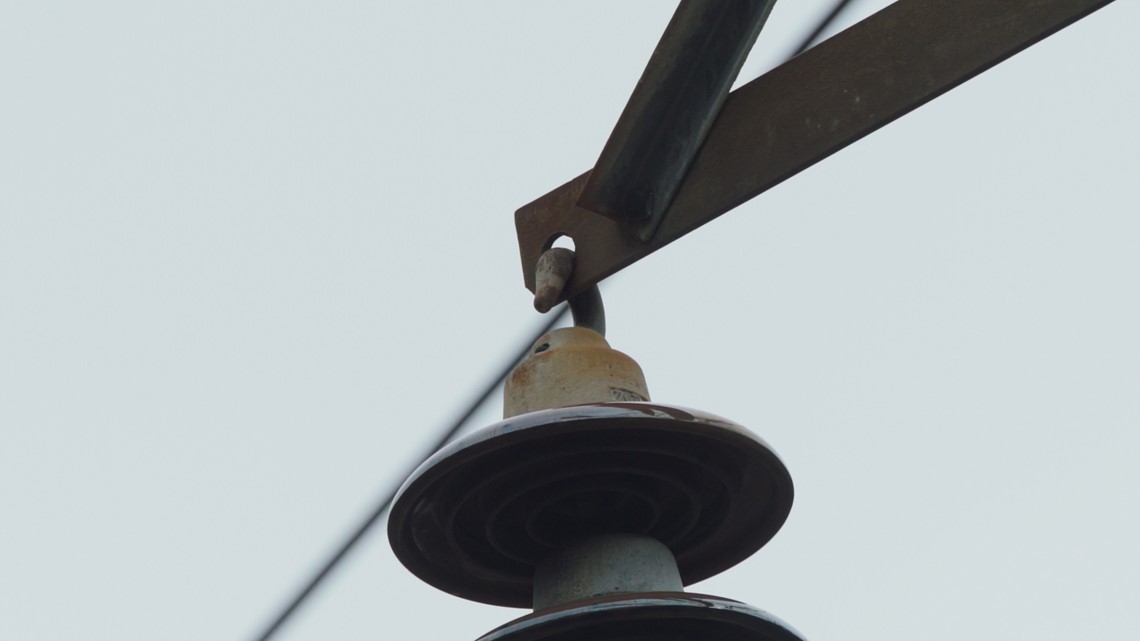
The image above shows a hook performing the same job as the one that broke on tower 222 of the Caribou line, located several miles up the canyon on tower 104.
This tower sits just across the highway from PG&E's helicopter pad in the canyon.
PG&E found worn holes on 13 towers belonging to the Caribou line that posed an immediate safety issue, according to the CPUC report.
"AN OVERALL PATTERN OF INADEQUATE INSPECTION AND MAINTENANCE"
The CPUC investigation is deeply critical of PG&E’s inspection and maintenance program.
“PG&E’s inspection and maintenance of the incident tower were not isolated," the CPUC report declared. "But rather indicative of an overall pattern of inadequate inspection and maintenance of PG&E’s transmission facilities.”
PG&E has previously pushed back against similar findings.
"PG&E denies that it has 'neglect[ed]' its transmission lines," PG&E wrote in a federal court filing earlier this year, in response to a judge's questions about a Wall Street Journal article about the company's safety practices.
When asked by ABC10 whether it still stands by that statement, PG&E did not answer.
However, PG&E told the same federal court this week that it doesn’t always know how old the parts on its own power lines are.
“Prior to the Camp Fire, PG&E did not specifically track the length of time that individual C-hooks and hanger plates on its overhead power lines had been in place,” the company said in court documents. “For various reasons, PG&E’s records may not in every instance allow PG&E to determine how long any particular C-hook or hanger plate has been in place.”
CLIMBING WAS SCHEDULED, JUST NOT IN TIME
Ironically, the CPUC report found that PG&E did make the decision to climb every tower on the Caribou line and began doing these inspections just two months before the fire.
These inspection crews hadn't yet made it to tower 222 on the day the fire sparked.
Even if they had, the CPUC report cast doubt on whether PG&E would have found the wear.
The CPUC report says that until two months before the fire, PG&E's climbing inspection forms did not have a place to record the condition of "cold-end hardware," which are non-energized parts like the hook that broke.
“This raises the question of whether inspectors were evaluating cold-end hardware even when they performed climbing inspections," the CPUC reported.
CRIMINAL INVESTIGATIONS ARE SEPARATE
The CPUC's report flagged 12 violations of state laws and regulations connected to the Camp Fire, including the failure to climb tower 222.
The company has reached a deal with the CPUC's safety division, which wrote the report, to settle these violations and others from the 2017 wildfires blamed on PG&E.
Under the terms of that proposed settlement, PG&E would agree not to try to pass its own wildfire expenses (like rebuilding power lines in neighborhoods that burned down) on to customers.
PG&E would also pay for $50 million of new safety initiatives, also at shareholder expense.
The settlement would be separate from the criminal investigation into the Camp Fire.
Butte County District Attorney Mike Ramsey told ABC10 that his office is exploring charges as serious as 85 counts of manslaughter for the deaths in the Camp Fire.
In May, Ramsey said it’s unclear whether charges would be filed against any individuals employed by PG&E, the company itself, or both.
PG&E is banned from committing new crimes under the terms of its federal probation, which lasts for two more years.
A jury found PG&E guilty of six federal felonies tied to the San Bruno Gas explosion, which killed eight people in 2010.
Because PG&E is a corporation, it could not receive prison time for those crimes.
The company was found guilty of violating the terms of its probation once before and federal judge William Alsup has previously explored his options for extending PG&E's time on probation in that case.
Brandon Rittiman is an investigative reporter for ABC10 and the creator of the original series FIRE - POWER - MONEY: California's burning crisis and how it's going to cost us all. Stream all three episodes below or by visiting FirePowerMoney.com.
Email Brandon and brittiman@abc10.com or reach him on Twitter of Facebook.
FOR NEWS IN YOUR COMMUNITY,
DOWNLOAD THE ABC10 APP:
►Stay In the Know! Sign up now for ABC10's Daily Blend Newsletter
In California, fires are burning more intensely than ever before. Megafires destroy entire neighborhoods. Some of the deadliest fires have been caused by our own electric grid, but all fires are burning worse because of climate change and an unhealthy forest landscape.



